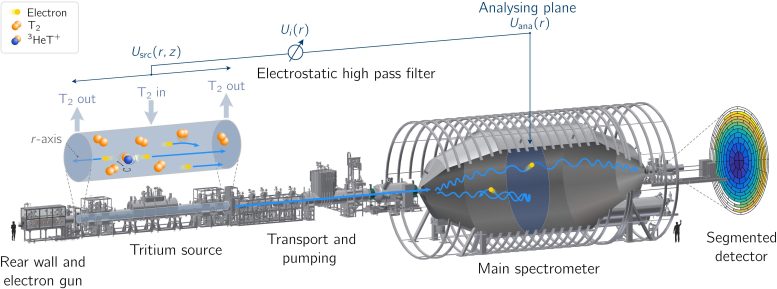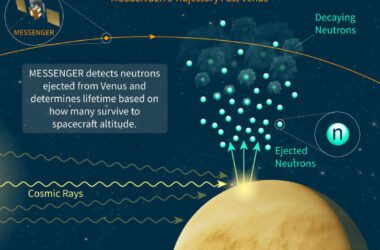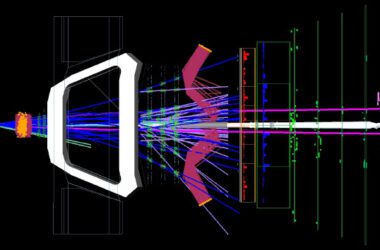
Vue du spectromètre principal de l’expérience KATRIN visant à déterminer la masse du neutrino sur le campus nord du KIT. Crédit : Markus Breig, KIT
Nouveau record mondial : Les neutrinos sont plus légers que 0,8 électron-volt.
Les neutrinos sont sans doute les particules élémentaires les plus fascinantes de notre univers. En cosmologie, ils jouent un rôle important dans la formation des structures à grande échelle, tandis qu’en physique des particules, leur très faible masse les distingue, laissant entrevoir de nouveaux phénomènes physiques au-delà de nos théories actuelles. Sans une mesure de la masse des neutrinos, notre compréhension de l’univers restera incomplète.
C’est le défi que s’est lancé le groupe international KArlsruhe TRItium Neutrinos (KATRIN) au KIT comme l’échelle la plus sensible au monde pour les neutrinos. Des partenaires de six pays sont impliqués. KATRIN utilise la désintégration bêta du tritium, un isotope instable de l’hydrogène, pour déterminer la masse du neutrino via la distribution d’énergie des électrons libérés dans le processus de désintégration. Cela nécessite un effort technologique important : L’expérience de 70 m de long abrite la source de tritium la plus intense au monde ainsi qu’un spectromètre géant permettant de mesurer les énergies des électrons de désintégration avec une précision sans précédent. Après avoir commencé les mesures scientifiques en 2019, la haute qualité des données a été continuellement améliorée au cours des deux dernières années. “KATRIN, en tant qu’expérience aux exigences technologiques les plus élevées, fonctionne désormais comme une horloge parfaite”, déclare le professeur Guido Drexlin du KIT, chef de projet et l’un des deux co-porteurs de l’expérience. Le professeur Christian Weinheimer, University of Münster, the other co-spokesperson, adds: “Reduction of the background rate and increase in the signal rate were decisive for the new result.”

Schematic representation of the setup of the KATRIN experiment. Credit: Leonard Köllenberger for the KATRIN collaboration
Detailed Data Analysis: First Push into the Range below 1 eV
In-depth analysis of these data represented a big challenge for the international team led by the two coordinators Dr. Magnus Schlösser, KIT, and Professor Susanne Mertens, Max Planck Institute for Physics and Technical University of Munich: Each and every effect on the neutrino mass, no matter how small, had to be investigated in detail. “This laborious and intricate work was the only way to exclude a systematic bias of our result due to distorting processes. We are particularly proud of our analysis team that accepted this huge challenge with great commitment and was successful, “ Schlösser and Mertens say. The experimental data from the first year of measurements and modeling based on a vanishingly small neutrino mass matched perfectly: It allowed them to determine a new upper limit of 0.8 eV for the neutrino mass, the scientists point out. This is the first time that a direct neutrino mass experiment has entered the sub-eV mass range that is of high relevance to cosmology and particle physics, as it is here where the fundamental mass scale of neutrinos is assumed to lie. “The particle physics community is excited that the 1-eV barrier has been broken by KATRIN,” comments neutrino expert John Wilkerson, University of North Carolina, who chairs the KATRIN Executive Board.
“The success was based decisively on the fact that the ramp-up of the source to nominal source intensities at the Karlsruhe Tritium Laboratory and the operation of the spectrometer, detector, and cryoinfrastructure went smoothly. This was due to the professional dedication of our highly motivated staff which supported this large-scale experiment,” Schlösser emphasizes.
Further Measurements to Improve Sensitivity
The researchers involved in the KATRIN project describe their next goals: “Further measurements of the neutrino mass will continue until the end of 2024. To exhaust the full potential of this unique experiment, we will steadily increase the statistics of signal events and continuously develop and install upgrades to further reduce the background rate.” The development of the new TRISTAN detector system will be of particular importance. From 2025, it will allow KATRIN to embark on a search for “sterile“ neutrinos with masses in the keV range. Such sterile neutrinos would be candidates for the mysterious dark matter that has already become manifest in many astrophysics and cosmological observations, but the physical nature of which is still unknown.
For more on this research, see New World Record: “Ghost Particle” Experiment Limits Neutrino Mass With Unprecedented Precision.
Reference: “Direct neutrino-mass measurement with sub-eV sensitivity” by The KATRIN Collaboration, 14 February 2022, Nature Physics.
DOI: 10.1038/s41567-021-01463-1



